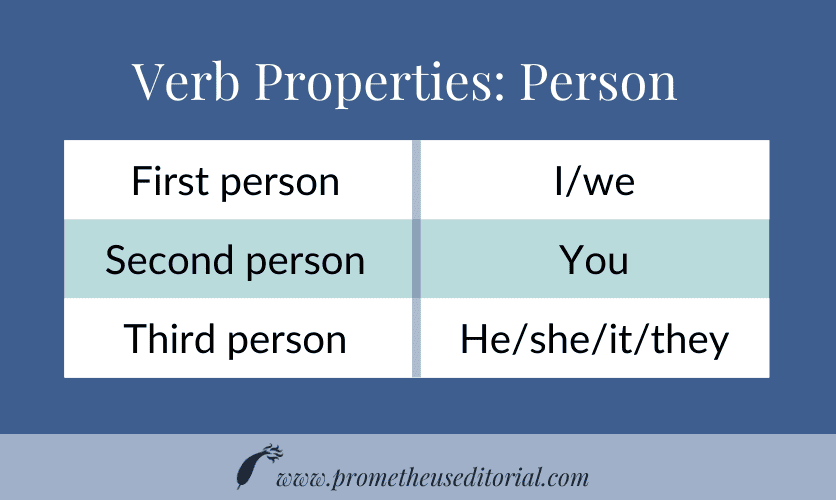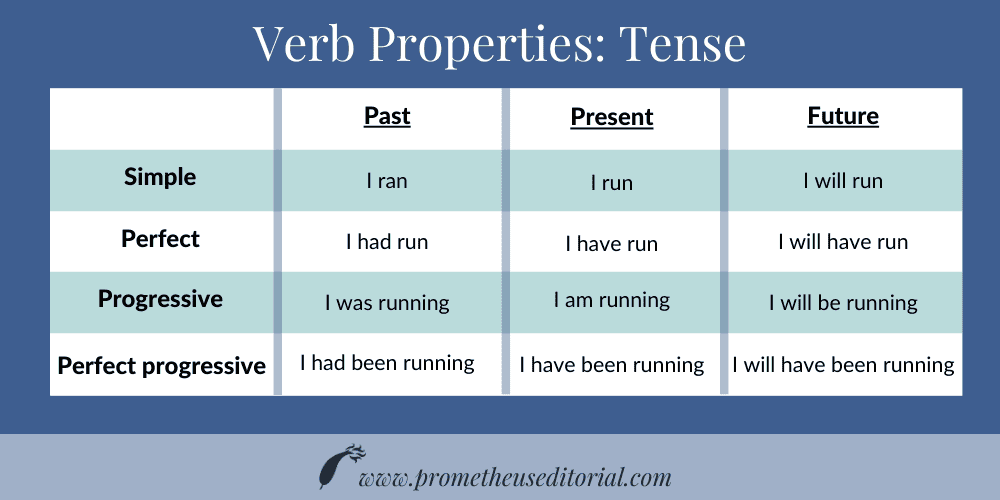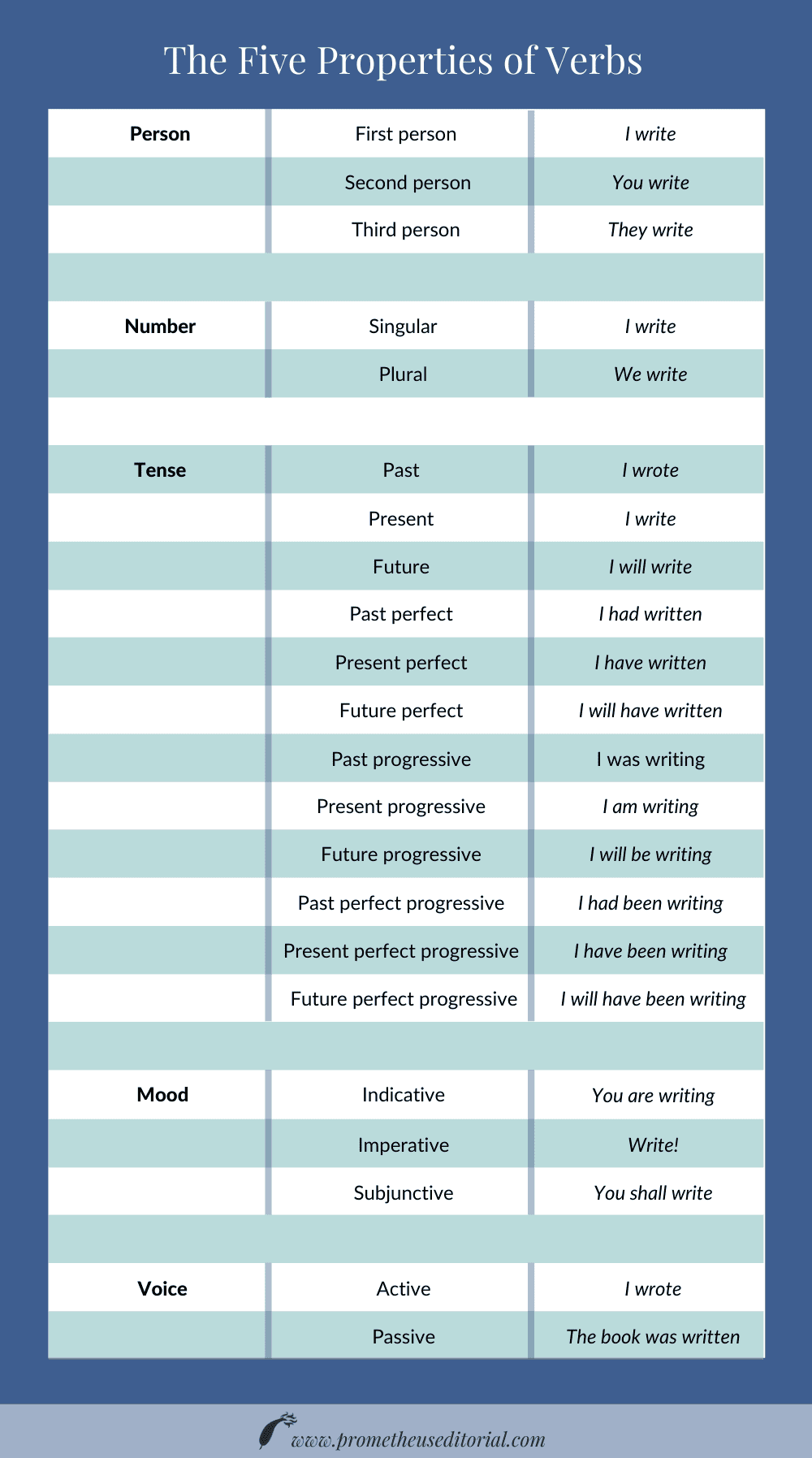The 5 properties of verbs
I spend a lot of time thinking about verbs.
They’re everywhere in the novels I edit. (If they weren’t, there would be something seriously wrong.)
And when it comes to verbs, it’s easy to use the wrong form.
As a copyeditor, I help authors improve the reader’s experience of their books, which means knowing what needs to be corrected and what should be left alone.
Fortunately, after getting a bachelor’s degree and Latin, I have a thorough understanding of grammar and have an easy time with this. So in this article, I wanted to share my knowledge of verbs with anyone who needs a bit of extra help.
In the English language, verbs have five properties. These are person, number, tense, mood, and voice.
Understanding these five properties of verbs can give you a better understanding of how verbs are used and how you can use them to improve your writing.
Person: the 1st property of verbs
Verbs can be either first person, second person, or third person. This property tells us whether the action was taken by the speaker, the person spoken to, or a separate third party.
The easiest way to identify the person is by looking at the pronoun that accompanies the verb.
First person verbs are preceded by the pronouns “I” and “we.”
Verbs in the second person are indicated by the pronoun “you.”
For third person, the verb is used alongside the pronouns “he,” “she,” “it,” and “they.” And sometimes with third person there will be a regular noun (a specific person or thing) rather than a pronoun.
If you want to brush up on pronouns, check out my article on mastering pronoun cases.
An infographic of the person property of verbs:
Number: the 2nd property of verbs
The number property indicates whether the subject of the verb is one person/thing or multiple people/things. (The subject is who/what is doing the verb.)
The two options for number are singular and plural. A singular verb has one person or things as a subject, while a plural verb has multiple people or things as subjects.
Like with the person property, an easy way to identify the number is by looking at the pronoun that accompanies the verb.
An infographic of the number property of verbs:
Notice that the pronouns “you” and “they” can be either singular or plural, but the verb forms are the same regardless of number.
Tense: the 3rd property of verbs
The tense property of a verb tells us when the action took place and indicates whether or not it is a continuous or completed action.
The English language has twelve tenses, which can be subdivided into three categories: past, present, and future. The tenses in each of these categories can be further subdivided into simple, perfect, progressive, and perfect progressive.
Now let’s break that down so it’s easy to understand. (I promise, it’s not as complicated as it seems!)
Past, present, and future tenses
Every action either happened in the past, is happening in the present, or will happen in the future. Below are the simple past, present, and future tenses.
Past: “I ran”
Present: “I run”
Future: “I will run”
The perfect tenses
Half of the English tenses are perfect tenses. They indicate a completed action and use the helping verb “to have” along with the past participle form of the verb.
If you don’t understand participles, don’t worry — you’ll catch on from the examples. Or you could check out Merriam-Webster’s definition.
Past perfect: “I had run”
Present perfect: “I have run”
Future perfect: “I will have run”
The progressive tenses
Six of the twelve English tenses are progressive tenses. These tenses are for actions that are ongoing or continuous.
The progressive tenses are formed by adding the appropriate form of the verb “to be” onto the present participle of the main verb. (That means “was” for the past, “is” for the present, and “will be” for the future. The present participle is the form ending in “-ing.”)
Past progressive: “I was running”
Present progressive: “I am running”
Future progressive: “I will be running”
The perfect progressive tenses are made up of the perfect forms of the verb “to be” along with the present participle of the main verb.
Past perfect progressive: “I had been running”
Present perfect progressive: “I have been running”
Future perfect progressive: “I will have been running”
An infographic with the tense property of verbs:
Mood: the 4th property of verbs
The English language has three moods. These are called the indicative, the imperative, and the subjunctive.
The mood indicates how the action is being expressed.
The indicative mood
The indicative mood is the one you are probably most familiar with and use most frequently. A verb is in the indicative mood when it makes a statement of fact or when it asks a question.
For example, “You brought me coffee, and I appreciate it” is indicative because it makes a statement of fact.
The imperative mood
The imperative mood is used when giving commands.
For example, “Bring me some coffee” is in the imperative. Contrast this with “Could you bring me some coffee?” which asks a question and is another example of the indicative.
The subject of a verb in the imperative mood is always you, whether singular or plural, but often the pronoun is implied rather than actually appearing in the sentence. (So it’s often “Bring me some coffee” rather than “You, bring me some coffee.”
The subjunctive mood
The subjunctive in English is used less frequently than it was in the past, but you probably still use it somewhat regularly without realizing it.
Continuing with our coffee examples, “If you brought me coffee, I would appreciate it.” This sentence is subjunctive because it talks about a hypothetical scenario (you bringing coffee) and speculates about what would happen (me appreciating it).
The subjunctive is used for statements that are in some way contrary to fact. This includes wishes, conjectures, demands, and suggestions.
Below are some of the different types of subjunctive contrasted with similar statements in the indicative and imperative moods.
The Subjunctive Mood for Wishes
“May the Force be with you” is subjunctive.
But “I hope that the Force will be with you” is indicative because it simply makes a statement of fact.
“Let them eat cake” is also subjunctive.
Note that “Let them eat cake” has the sense of “May they eat cake.” If the meaning were “Allow them to eat cake,” that would be the imperative because you’re giving someone a command.
The Subjunctive Mood for Conjectures
“If I were you, I wouldn’t do that.” This is another subjunctive.
But “I don’t recommend doing that” is indicative and “Don’t do that” would be imperative.
The Subjunctive Mood for Demands
“You shall not pass!” Another subjunctive.
But “Do not pass!” is imperative and “You cannot pass!” is indicative.
“Shall not” talks about a hypothetical of what the speaker believes should happen in the future, demanding that the other person not take that action. “Do not” is giving a command. “Cannot” talks about what is currently fact, informing the other person that an action is impossible.
The Subjunctive Mood for Suggestions
“She suggested that they read The Chicago Guide to Grammar, Usage, and Punctuation by Bryan Garner to learn about the subjunctive in more detail.”
But “She suggested that they are reading…” is indicative.
Common words and phrases for recognizing the subjunctive:
If a sentence contains a “may,” “let/let’s,” “shall,” “should,” “could,” or “would,” you might be looking at a verb in the subjunctive mood. Each of these words, however, can also occur in non-subjunctive contexts.
Some common phrases that use the subjunctive are “suffice it to say,” “be that as it may,” “if need be,” and “God bless you.”
An infographic with the mood property of verbs:
Voice: the 5th property of verbs
In English, we have two options for the voice property. These are the active voice and the passive voice.
The active voice is used when the subject of the verb is doing the action. The passive voice is used when the subject of the verb is having the action done to it.
Active: “The author wrote the book.”
The author is the subject of this sentence. Since they are doing the action, the verb is active.
Passive: “The book was written by the author.”
The subject here is the book. Since it’s having the action done to it, this verb is passive.
Both examples describe the same thing. The difference is the perspective from which the action is being described. (This is worth paying attention to because it can change the emphasis and the impact of the sentence.)
An infographic with the voice property of verbs:
Why learn the 5 properties of verbs?
Native English speakers have an intuitive understanding of how our language works. We typically know which verb forms to use for a particular situation without having to think about it.
So why is it important to learn grammar concepts like the five verb properties?
Gain a deeper understanding of grammar
Learning terms and definitions provides a way to think about a topic more critically. It helps solidify your understanding in a concrete way so that you know not just that a form is correct but why it’s correct.
If you want to be able to analyze your writing and verify that all verbs are being used correctly, you need the right vocabulary.
It becomes much more difficult to keep track of what tenses you’re using if you don’t know what they’re called. This can lead to blunders such as changing tenses mid-sentence or switching to the passive voice without changing your subject.
And if you are ever unsure of something and need to look it up, you will need to know what term to find in your grammar book or to type into Google.
Become a better writer
Learning about the five properties of verbs makes you a better writer.
You may already have an intuitive understanding of verb forms. But being able to break down a verb and explain what exactly it is adding to a sentence helps you become a more skillful writer.
Whenever you sit down to write, it’s important to make sure you are communicating clearly and effectively and keeping your readers engaged. Correctness is important because readers will find errors distracting.
But language is an art, not a science, and it goes well beyond just correctness. Language is powerful, and the better you can understand it, the more you can harness its power to accomplish whatever you’re setting out to do.
If you want to step up your writing game even further, check out these writing tips on making your writing more readable.
Recap: the 5 properties of verbs (examples)
Person:
- First person: “I write”
- Second person: “You write”
- Third person: “They write”
Number
- Singular: “I write”
- Plural: “We write”
Tense
- Past: “I wrote”
- Present: “I write”
- Future: “I will write”
- Past perfect: “I had written”
- Present perfect: “I have written”
- Future perfect: “I will have written”
- Past progressive: “I was writing”
- Present progressive: “I am writing”
- Future progressive: “I will be writing”
- Past perfect progressive: “I had been writing”
- Present perfect progressive: “I have been writing”
- Future perfect progressive: “I will have been writing”
Mood
- Indicative: “You are writing”
- Imperative: “Write!”
- Subjunctive: “You shall write”
Voice
- Active: “I wrote”
- Passive: “The book was written”











